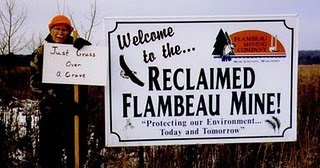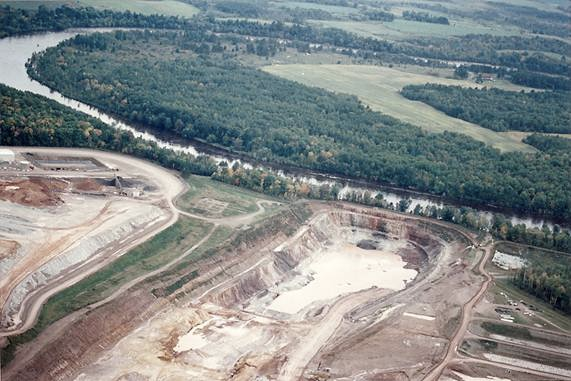EXPANDED INFORMATION - REGIONAL / TRIBAL / LEGAL
July 25 2012
For more information contact: Laura Gauger
Court Rules Flambeau ‘Model Mine’ Violated Clean Water Act
State Officials Urged to ‘Learn from Flambeau’ and Stop Proposed
Mega-Mines in Wisconsin, Minnesota and Michigan

Roscoe holding a sign " Grass over Grave" Now the Federal Court agrees!
A federal court ruled yesterday that Flambeau Mining Company (FMC) violated the Clean Water Act on numerous occasions by allowing pollution from its Flambeau Mine site, near Ladysmith, Wis., to enter the Flambeau River and a nearby tributary known as Stream C.
The lawsuit was filed early last year by the Wisconsin Resources Protection Council (WRPC), the Center for Biological Diversity, and Laura Gauger. The complaint charged that Flambeau Mining Company (a subsidiary of Kennecott Minerals Company / Rio Tinto) was violating the Clean Water Act by discharging stormwater runoff containing pollutants, including toxic metals like copper and zinc, from a detention basin known as a biofilter.
For details on the court ruling, please see the attached press release issued by the Wisconsin Resources Protection Council, the Center for Biological Diversity and Gauger.

The Flambeau Mine near Ladysmith, WI has a long history of controversy due, in part, to the proximity of the mine to the Flambeau River. A federal court ruled yesterday that the mine, which ceased operations in 1997 and has since been reclaimed, violated the federal Clean Water Act on numerous occasions over the past 6 years. This photo was taken in September 1994, when heavy rains caused flooding at the mine site.
The Flambeau is a popular river for fishing and canoeing and provides habitat for a wide variety of aquatic and wildlife species, including bald eagles and osprey. The Flambeau Mine operated near the river from 1993 to 1997. Since the close of mining operations, Flambeau Mining Company has faced persistent groundwater and surface water quality problems at the site, most notably at a 32-acre industrial park that remains operational.
As long-time mining opponent Roscoe Churchill of Ladysmith, Wisconsin said in 2002, “Maybe I won’t live long enough to see the pollution. But I’ve studied enough mines to know that it’s not a matter of if, it’s a matter of when. It’s a kettle of poison and eventually it’s going to find its way into the Flambeau.” Mr. Churchill, who spearheaded local efforts to stop construction of the Flambeau Mine in the 1990s, passed away in 2007.
Regional Implications
The pollution caused by the relatively small Flambeau Mine takes on added significance in light of new proposals for copper, nickel, zinc and iron mines in the Great Lakes region. Projects under consideration include NorthMet (Babbitt, MN), Penokee Hills (Mellen, WI), Eagle (Big Bay, MI), Back Forty (Stephenson, MI), Copperwood (Ironwood, MI) and Lynne (Tripoli, WI), among others. The ore deposits and/or host rock at these sites, as was the case for the Flambeau Mine, contain sulfide minerals known to produce toxic acid mine drainage. The proposed mines, however, would be significantly larger than the Flambeau Mine.
Gauger is urging state regulators in the Great Lakes region to “learn from Flambeau” and halt the proposed mega-mines in Wisconsin, Minnesota and Michigan. Her concern is that high levels of toxic pollutants in the surface water and groundwater at the Flambeau Mine site could not be prevented despite state-of-the-art technology and the relatively small size of the mine
She explained: “If the Flambeau Mine were a pea, these other proposals would be watermelons. If they couldn’t get it right at Flambeau, how are they going to get it right at Penokee, NorthMet or any of the other sulfide mines proposed for the region?
Historical Perspective
This case is not the first time that citizens or tribal members have sought legal action against FMC for water pollution problems at the Flambeau Mine site. As far back as 2004, the Great Lakes Indian Fish and Wildlife Commission (GLIFWC) under the leadership of the late James Schlender, Sr. pressed the Wisconsin Department of Natural Resources (DNR) to take enforcement action against FMC for discharging pollutants into Stream C. The Commission represents 11 Ojibwe tribes in Minnesota, Wisconsin, and Michigan who reserved hunting, fishing and gathering rights in various treaties with the United States government in the mid 1800’s. The Flambeau Mine site falls within the affected area, also known as “tribal ceded territory.”
As Mr. Schlender stated in a September 29, 2004 letter to the Wisconsin DNR, “The Department should seek to ensure accountability as well as to provide deterrence against future violations not only by this Company but by others who may be in a position to pollute ceded territory waters.” The DNR failed to act on Mr. Schlender’s request to pursue enforcement action against FMC.
A second attempt to hold FMC accountable for water pollution problems at the Flambeau Mine site was launched in 2009, when WRPC and Gauger filed a notice of intent to sue the company and the Wisconsin DNR in State of Wisconsin Circuit Court. Besides the high levels of copper in Stream C, another issue raised in the notice letter was the consistent and statistically significant exceedances of groundwaterstandards in a well between the backfilled pit and the Flambeau River. In particular, manganese levels in this well, located just 125 feet from the river bank, have registered as high as 5600 parts per billion (ppb),over ten times the mine permit standard of 550 ppb.
Another well at the Flambeau Mine site, this one within the backfilled pit, has registered manganese levels in excess of 40,000 ppb. As reported in the medical literature, drinking water with that much manganese in it has been associated with causing the kind of nerve damage seen in Parkinson’s disease. Per the terms of Wisconsin’s mining laws, however, this particular well at the Flambeau Mine site is exempt from having to meet state groundwater standards, as are all the wells located within the backfilled pit and for up to 1200 feet from the buried waste rock (see NR 182.075(1)(b), Wisconsin Administrative Code). This encompasses an area of nearly a square mile at and near the mine site where the groundwater can be polluted by FMC to an unlimited degree.
The plaintiffs decided not to push forward with the 2009 case in State of Wisconsin Circuit Court when, according to Gauger, “it became clear that Wisconsin’s mining laws contained too many loopholes and the Wisconsin Department of Justice was siding with the mining interests.”
She added, “I am not Native and cannot speak for the tribes. But I agree with what I was told by a tribal elder: ‘The land and our children are the issue. Our lands and waters are being desecrated by the mining companies. What’s left for the children after those companies are gone?’ That’s why there was no choice but to keep fighting and take this case to federal court.”
Background Information on the Flambeau Mine and Clean Water Act Case
The Flambeau Mine operated within 150 feet of the Flambeau River in the mid-1990s and produced copper, gold and silver. FMC ceased mining operations in 1997, and the mine site has been undergoing reclamation ever since. A partial Certificate of Completion for mine reclamation was issued by the Wisconsin Department of Natural Resources (DNR) in 2007; however, an approximately 32-acre parcel known as the “Industrial Outlot” was not included in that process and remains subject to DNR mining regulations.
The Industrial Outlot includes several industrial buildings and facilities, a parking area and a 0.9-acre, man-made pond that has been modified by FMC on several different occasions over the years to treat contaminated runoff from the mine site. During the mine’s operational years (1993-1997), the pond, or detention basin, was described by FMC as a “surge pond” and served as an integral part of the mine’s wastewater treatment system. At that time it contained a liner and was used to store highly toxic acid mine drainage and runoff from the open pit mine before the water was pumped to an on-site wastewater treatment plant for processing and eventual discharge to the Flambeau River.
In 1998, after mining operations ceased and the pit was backfilled with waste rock, FMC decommissioned the wastewater treatment plant (according to the terms of the reclamation plan approved by the State of Wisconsin) and converted the “surge pond” to what the company described as a “biofilter.” The liner remained beneath the pond, but now, instead of receiving acid mine drainage from the open pit, the pond received contaminated stormwater runoff from the Industrial Outlot. The runoff contained particulates and dissolved metals like copper and zinc. The biofilter entrapped at least some of the particulates, which settled to the bottom of the pond. But the water, which still contained dissolved metals, passively discharged to Stream C.
Per agreement with the DNR and as a condition of its partial Certificate of Completion for mine reclamation, FMC monitored and analyzed the discharge from the biofilter to Stream C approximately twice a year between 1998 and early 2012. Discharges from the biofilter were largely induced by precipitation, which caused the biofilter to overflow through a narrow outlet to Stream C. Lab results since 1998 have shown that copper levels in the discharge have greatly exceeded Wisconsin’s toxicity standards set to protect fish and other aquatic species. Specifically, copper levels in the discharge ranged from 5 to 91 ppb, while the state’s chronic toxicity standard for copper is 3 ppb. Elevated zinc and iron were also reported by FMC.
In early 2012, after the present lawsuit was filed, FMC pulled the liner from the bottom of the biofilter and converted it to what the company refers to as an “infiltration basin.” This allows the contaminated runoff to seep into the earth instead of being directed to Stream C. Nevertheless, a recommendation from the Wisconsin Department of Natural Resources still stands that Stream C be added to the state’s list of “impaired waters” due to elevated and toxic levels of copper and zinc from the mining operation.
Legal Claim Asserted
The federal Clean Water Act makes it unlawful to discharge pollutants from a point source to waters of the United States without a permit issued under the National Pollutant Discharge Elimination System (“NPDES”). Both the U.S. EPA and the DNR (which has been delegated authority to issue NPDES permits in Wisconsin under its parallel program, the WPDES) commonly issue permits to point-source discharges of industrial stormwater such as the discharge from FMC’s biofilter. The most important function of an NPDES permit is to ensure that all applicable water quality standards are maintained. FMC never had an NPDES permit authorizing the discharge of copper, zinc, iron, and other pollutants from the biofilter to Stream C, and therefore was in violation of the Clean Water Act.
The Clean Water Act contains a “citizen suit” provision that authorizes citizens and organizations to file a federal lawsuit against polluters alleged to be (a) discharging pollution without an NPDES permit, or (b) violating the terms and limitations of an existing NPDES permit. The complaint filed by WRPC, CBD and Gauger alleged that FMC was in violation of the Clean Water Act’s prohibition on the discharge of pollutants without an NPDES permit, and the Court agreed.
